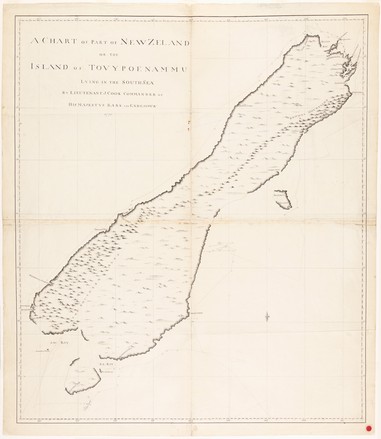A chart of part of New Zealand or the island of Toui Poenammu
1770
Manuscript map
Bequest of Sir William Dixson, 1952
DL SPENCER 166
In mid August 1769, after almost four months in Tahiti, Cook sailed south into uncharted waters, and on 7 October 12-year-old cabin boy Nicholas Young sighted land. Honouring his promise to reward the first person to sight land, Cook named the headland Young Nicks Head after him.
Two days later Cook landed at Poverty Bay, where skirmishes resulted in the deaths of several Māori. He then sailed south to Cape Turnagain, then north, pausing at Tolaga Bay and Anaura Bay before rounding East Cape to Mercury Bay. After a week in the Bay of Islands, he turned the top of the North Island in a storm, and sailed down its west coast, before heading west in April 1770 in search of Van Diemen’s Land. Forced north by winds, his expedition came upon the east coast of Australia.
Observing the land sometimes from well out to sea, Cook made two famous errors in these charts: he charted Banks Peninsula as a probable island and Stewart Island as a probable peninsula. Both errors can be seen.
No greater prize
On 19 February 1938 Dixson’s London dealer, A H Spencer, wrote a long and detailed letter to Sir William describing his latest discovery and offering the two manuscript charts of New Zealand to him. The letter begins:
"I think you will not regard it as presumptuous when I say that we can consider it a miracle that I am able to submit to you the following item….
These are the reasons why I remained in England for so long, for after I first heard of them it took me five months to get them into my hands. I was determined not to leave England without them, and persistence plus tenacity won the day. I feel so proud in being able to submit them to you
Could I have brought back from London a greater prize!"
Spencer examined and compared the charts to those held at the British Museum to confirm their authenticity, comparing the hand writing and style of lettering. His concluding paragraph continues:
"It would be impossible and legitimate to write pages about the present historic value and accruing historical value of these great chart as time rolls on; but should I carry coals to Newcastle? Not when writing or speaking to you, certainly. Therefore I shall not write another word save to say that I am fully seized with the wonder of the Charts; but your imagination is quite as vivid as mine. I mean, much could be written, but to you it would be redundant and in my opinion therefore offensive. I know that I tremble every time I look and touch these charts. Yes, I slept with them under my pillow more than once.
With kind regards,
Yours sincerely,
A. H. Spencer"



 Back to list
Back to list